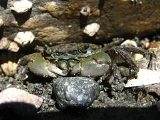
Yellow shore crab
Encyclopedia
Hemigrapsus oregonensis is a small shore crab
of the family Varunidae
; it was formerly classified under the family Grapsidae
. It is known under several common name
s, including yellow shore crab, hairy shore crab, green shore crab, mud-flat crab, and Oregon shore crab.
Despite its name, the body color of this crab can vary. Often, it has a light grey, green or yellow carapace
with small blue/black spots and lighter colored legs with similar spots, but it may be red/brown with green spots. The legs with claws (chelipeds) are usually cream/white with no spots.
This species typically lives in mud flats and can be found in large numbers in the San Francisco Bay
, and coastal areas of Oregon
and Washington states in the United States
. Its diet primarily consists of diatom
s and green algae
, but it will occasionally eat meat.
Although closely related, the adult H. oregonensis is smaller (3 centimetre) than the purple shore crab
, H. nudus. It can be distinguished from H. nudus by observing the legs and claws – the legs of H. oregonensis, but not H. nudus, are covered in many hairs called seta
e, while the claws of H. nudus, but not H. oregonensis, are covered in purple or red spots.
Crab
True crabs are decapod crustaceans of the infraorder Brachyura, which typically have a very short projecting "tail" , or where the reduced abdomen is entirely hidden under the thorax...
of the family Varunidae
Varunidae
Varunidae is a family of thoracotrematan crabs. The delimitation of this family, part of the taxonomically confusing Grapsoidea, is undergoing revision. For a long time, they were placed at the rank of subfamily in the Grapsidae, but they appear to be closest to Macropthalmus and the Mictyridae,...
; it was formerly classified under the family Grapsidae
Grapsidae
Grapsidae is a family of crabs known variously as marsh crabs, shore crabs or talon crabs. It is not confirmed that the family forms a monophyletic group and some taxa may belong in other families...
. It is known under several common name
Common name
A common name of a taxon or organism is a name in general use within a community; it is often contrasted with the scientific name for the same organism...
s, including yellow shore crab, hairy shore crab, green shore crab, mud-flat crab, and Oregon shore crab.
Despite its name, the body color of this crab can vary. Often, it has a light grey, green or yellow carapace
Carapace
A carapace is a dorsal section of the exoskeleton or shell in a number of animal groups, including arthropods such as crustaceans and arachnids, as well as vertebrates such as turtles and tortoises. In turtles and tortoises, the underside is called the plastron.-Crustaceans:In crustaceans, the...
with small blue/black spots and lighter colored legs with similar spots, but it may be red/brown with green spots. The legs with claws (chelipeds) are usually cream/white with no spots.
This species typically lives in mud flats and can be found in large numbers in the San Francisco Bay
San Francisco Bay
San Francisco Bay is a shallow, productive estuary through which water draining from approximately forty percent of California, flowing in the Sacramento and San Joaquin rivers from the Sierra Nevada mountains, enters the Pacific Ocean...
, and coastal areas of Oregon
Oregon
Oregon is a state in the Pacific Northwest region of the United States. It is located on the Pacific coast, with Washington to the north, California to the south, Nevada on the southeast and Idaho to the east. The Columbia and Snake rivers delineate much of Oregon's northern and eastern...
and Washington states in the United States
United States
The United States of America is a federal constitutional republic comprising fifty states and a federal district...
. Its diet primarily consists of diatom
Diatom
Diatoms are a major group of algae, and are one of the most common types of phytoplankton. Most diatoms are unicellular, although they can exist as colonies in the shape of filaments or ribbons , fans , zigzags , or stellate colonies . Diatoms are producers within the food chain...
s and green algae
Green algae
The green algae are the large group of algae from which the embryophytes emerged. As such, they form a paraphyletic group, although the group including both green algae and embryophytes is monophyletic...
, but it will occasionally eat meat.
Although closely related, the adult H. oregonensis is smaller (3 centimetre) than the purple shore crab
Purple shore crab
The purple shore crab, Hemigrapsus nudus, is a common crab of the family Varunidae. It can be found sheltering under rocks in inter-tidal areas along the west coast of North America, from Alaska to Baja California in Mexico. This crab primarily eats sea lettuce and other green algae, and...
, H. nudus. It can be distinguished from H. nudus by observing the legs and claws – the legs of H. oregonensis, but not H. nudus, are covered in many hairs called seta
Seta
Seta is a biological term derived from the Latin word for "bristle". It refers to a number of different bristle- or hair-like structures on living organisms.-Animal setae:In zoology, most "setae" occur in invertebrates....
e, while the claws of H. nudus, but not H. oregonensis, are covered in purple or red spots.

